Egyptian Art
1/42
There's no tags or description
Looks like no tags are added yet.
Name | Mastery | Learn | Test | Matching | Spaced |
|---|
No study sessions yet.
43 Terms
Palette of Narmer
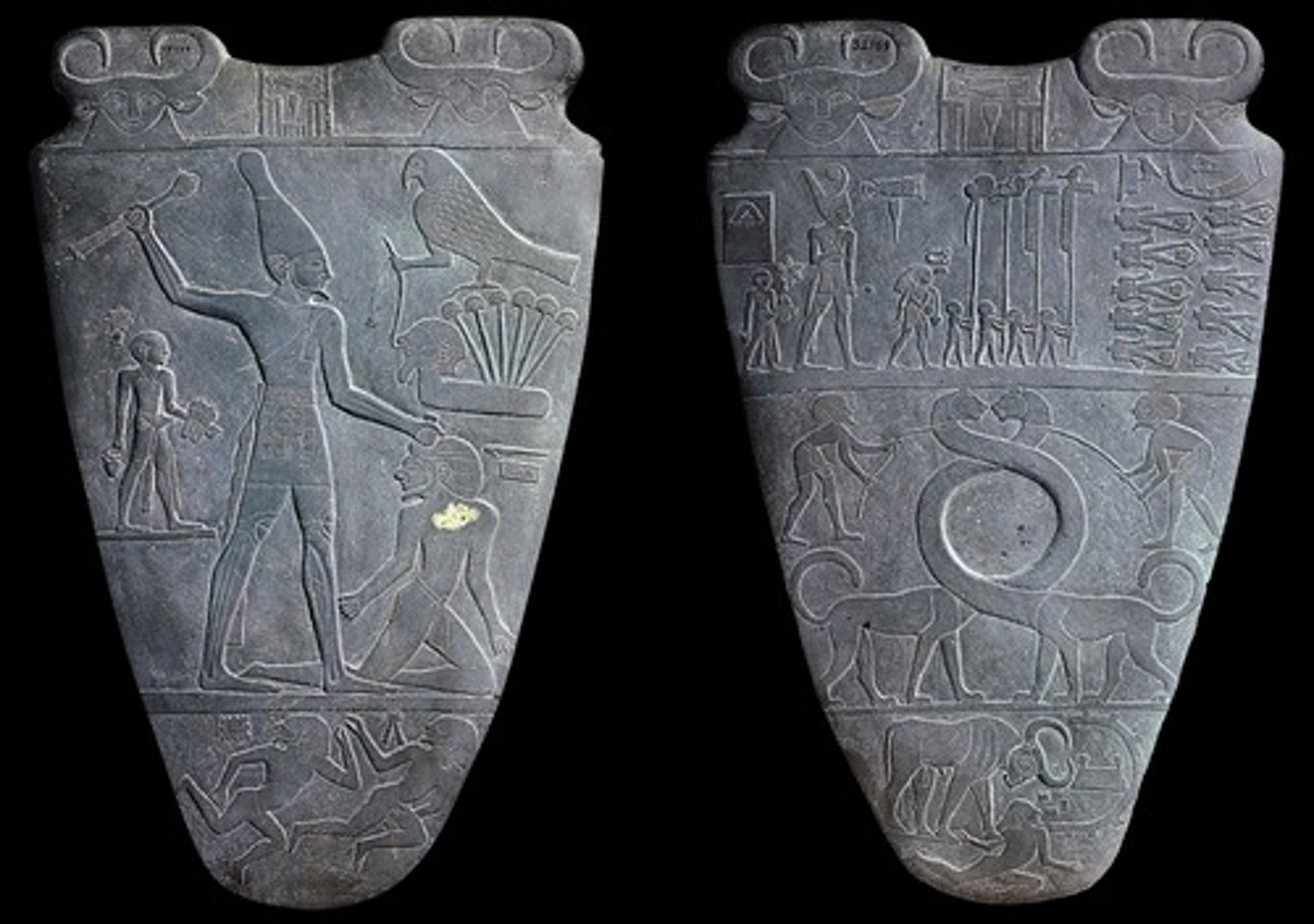
Palette of Narmer ID
era- Predynastic
audience- gods
patron- Narmer?
materials- greywacke
techniques- subtractive sculpture, bas relief
Palette of Narmer location
Temple of Horus
Palette of Narmer content
3 registers; side 1: top register- goddess Hathor, god showing approval; middle register- Narmer beating enemy with weapon in hand, headdress= upper Egypt, Horus holing papyrus (lower Egypt), servant holding Narmer's shoes= holy space; bottom register- 2 nude dudes running away; side 2: top register- Hathor; middle register- decapitated bodies between Narmer's legs, 2 stylized felines intertwined to represent upper/lower Egypt; bottom register- bull knocking down citadel
Palette of Narmer context
Narmer unified upper/lower Egypt; palette; Horus was protector god who gave power to first human king; gods represented by animals/composites, Horus=eagle; used in ritual to Horus; predynastic is before the pharaohs and family succession; historical, ritual, narrative
Seated Scribe
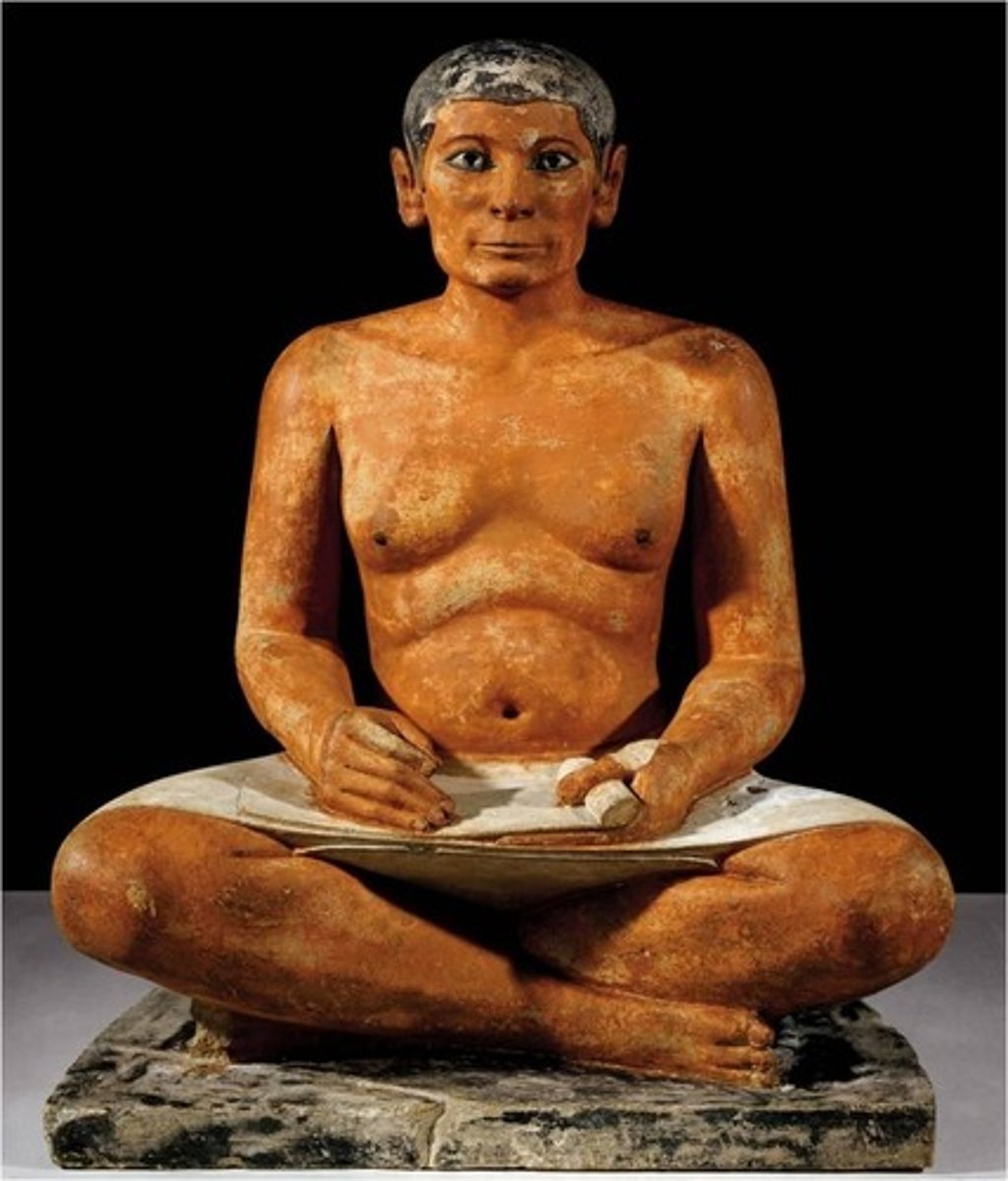
Seated Scribe ID
era- Old Kingdom
audience- gods, pharaoh's ka
patron- Kai (gov. official)
materials- paint, limestone, crystal, copper
techniques- subtractive sculpture, inlay
Seated Scribe location
necropolis in Saqqara, Egypt
Seated Scribe content
holding papyrus scroll and writing tool; realistic/naturalistic; wearing Egyptian kilt and sitting cross legged; fleshy torso; no emotion, neutral expression is eternal; wise thinker; inward attention but facing forward; alert,colorful eyes from crystal and organic material; painted for realism; sculpture in. the round; unusual to have such realistic statue for scrive status
Seated Scribe context
found near tomb of Kai; possibly larger base with inscription that would've ID the scribe; statue near Kai's tomb so scribe could serve Kai in afterlife; funerary
Menkaure and Queen
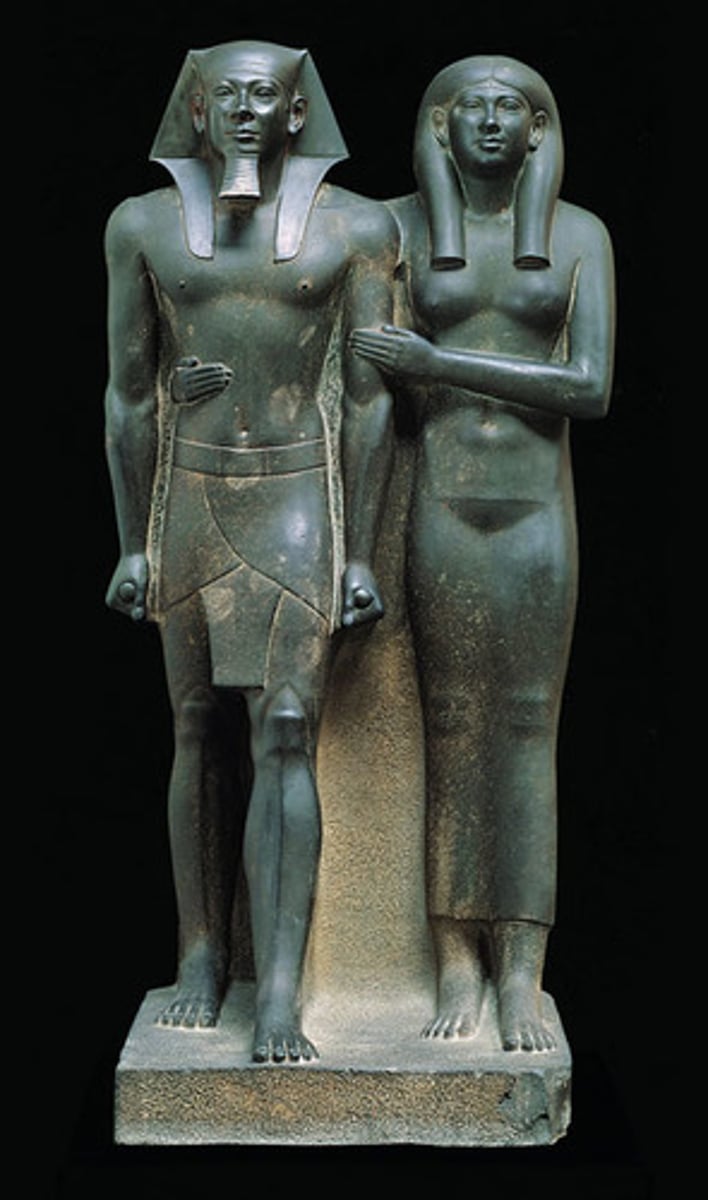
Menkaure and Queen ID
era- Old Kingdom
audience- gods, pharaoh's ka
materials- greywakce
technique- subtractive sculpture
Menkaure and Queen location
necropolis in Giza
Menkaure and Queen content
dyad sculpture; Menkura: pharaoh's headdress, young/ideal/neutral face (emotion is temporary, neutrality is eternal), beard of wisdom, muscular torso, hands at sides holding scrolls, one foot in front of the other, weight evenly distributed; Queen: young/ideal hair, dependent- holding onto Menkaure, body set behind Menkaure, dressed in clingy clothing, foot forward (unusual for woman), could be Menkaure's mother; high relief with detail, compact, sculpture in the round; painted bodies
Menkaure and Queen context
sculpture in a niche- helps to be frontal view; preform rituals/male offerings to pharaoh; Osiris- god of underworld, depicted with green skin; pharaoh becomes Osiris in death, red paint fades revealing dark green stone/skin; title sued to include Queen's name, but could be Menkaure's mom, guiding him to rebirth in afterlife; ka sculpture, religious, funerary
Pyramids at Giza & Sphinx
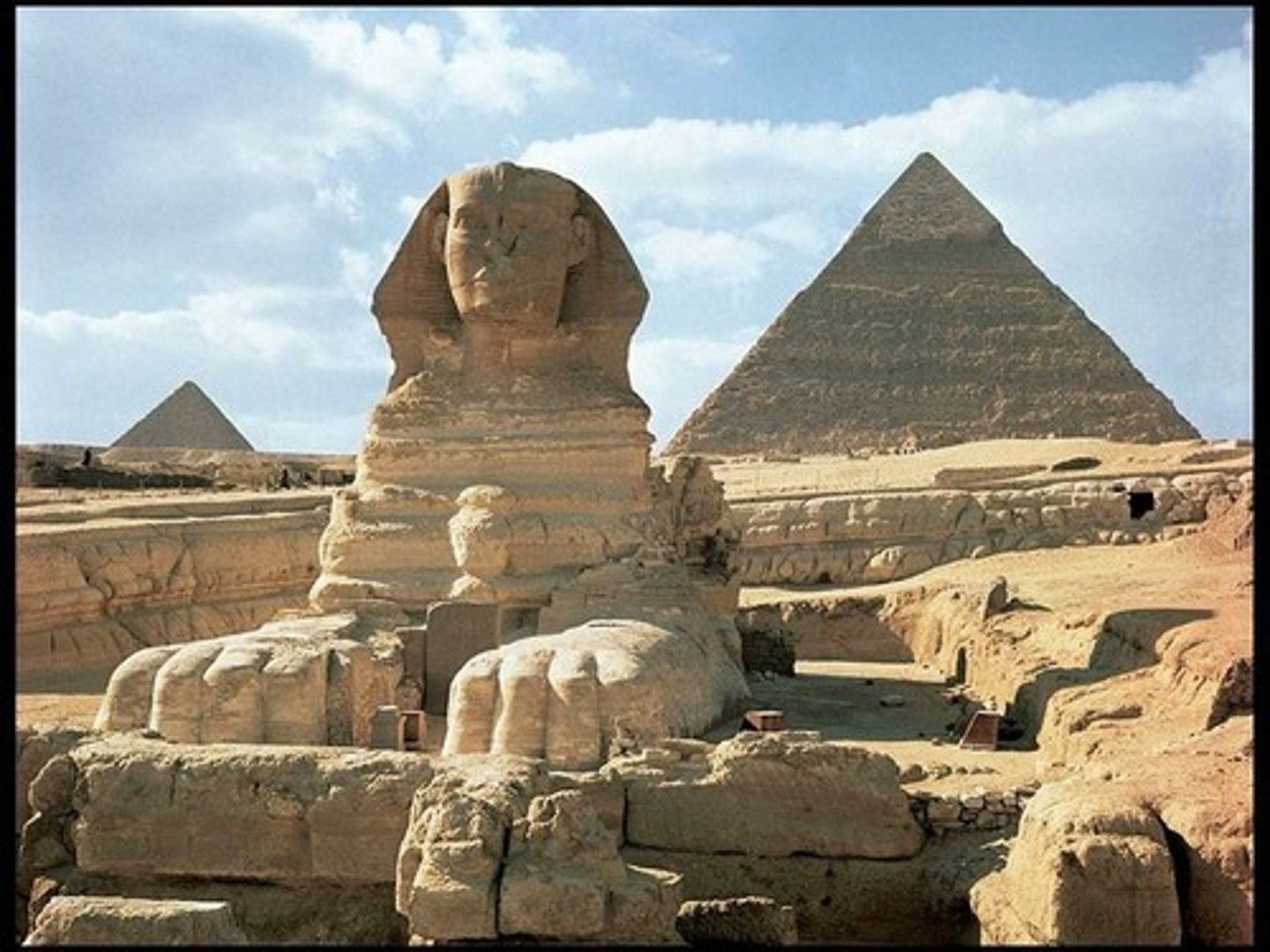
Pyramids at Giza & Sphinx ID
era- Old Kingdom
audience- public, gods, pharaoh's ka
patron- Khufu, Menkaure, Khafre
materials- limestone
techniques- ashlar masonry
Pyramids at Giza & Sphinx content
3 pyramids in necropolis; biggest pyramid= Khufu, middle= Khafe, smallest= Menkaure; made of limestone; ashlar masonry, dressed stone, causeways connect tombs to funerary temples; Sphinx: lion and head of Khafre, guardian figure; pyramids face compass points, sides covered in limestone to make them smooth, apex of pyramids painted white to reflect sun; other structures in necropolis were smaller tombs for family and officials, storage, just outside were homes for builders
Pyramids at Giza & Sphinx context
pyramids are tombs, funerary temples for rituals; west fo the Nile, when pharaoh dies they are floated down the nile to prepare body in temple of Giza; once placed in pyramid, pharaoh ascends pyramid ramp to reunite with Ra (sun god); shape of pyramid is a sunray; capstone symbolizes benben stone; old kingdom/early dynastic is only era when pyramids are made- politically/socially stable; funerary/ritual/power
Temple of Amun-Re and Hypostyle Hall
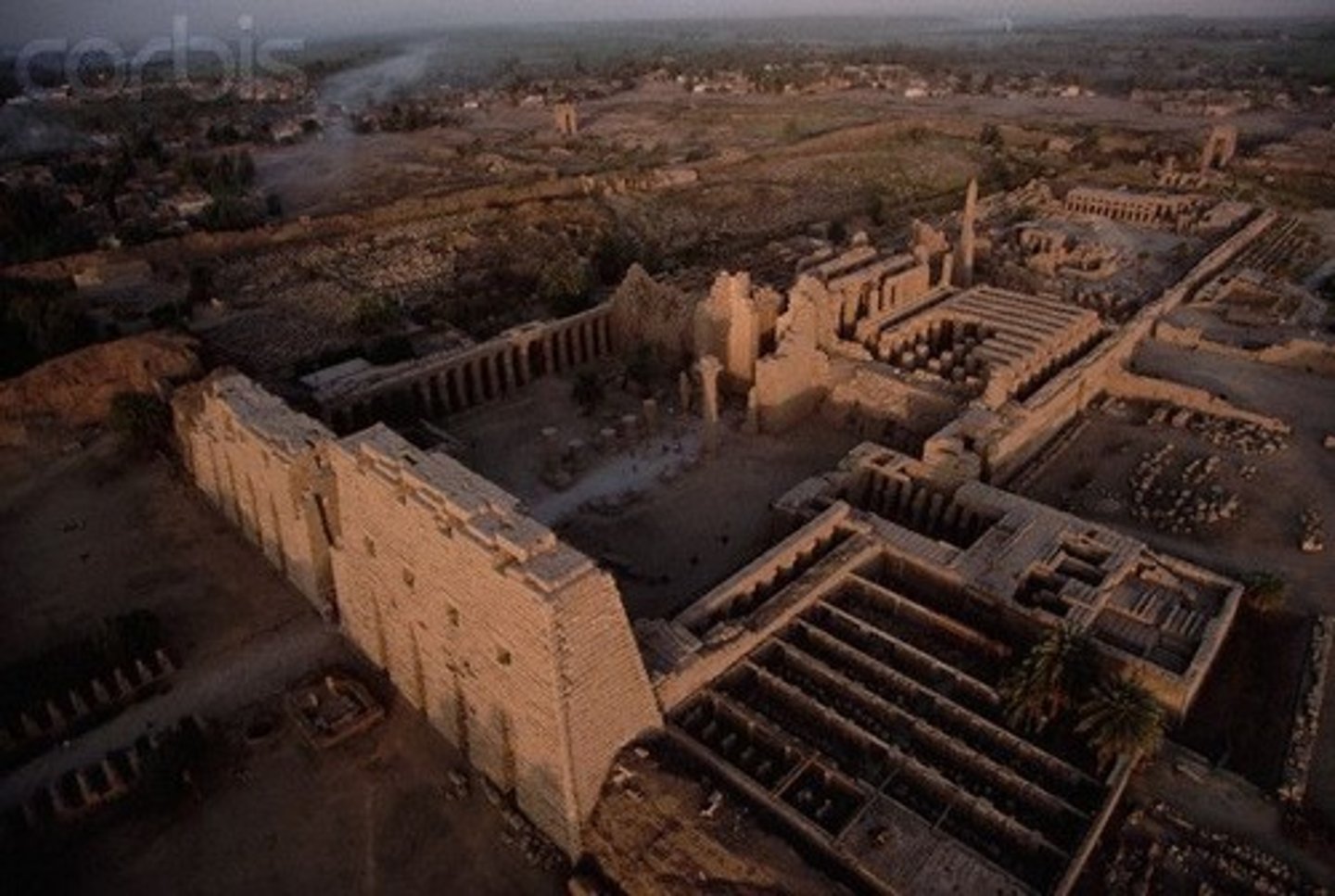
Temple of Amun-Re and Hypostyle Hall ID
era- New Kingdom
audience- gods, pharaohs, priests, public
patron- various pharaohs
materials- mudbrick, sandstone
techniques- pylon, hypostyle hall
Temple of Amun-Re and Hypostyle Hall location
Karnak, Egypt
Temple of Amun-Re and Hypostyle Hall content
enter through pylon to open peristyle courtyard, then move into Hypostyle hall, capitals are blossoms; columns in center are taller= ceiling taller in center; clerestory; columns have sunken relief; axial/longitudinal plan; floor raises up as you move from space to space;
Temple of Amun-Re and Hypostyle Hall context
New Kingdom= temples to gods/pharaohs who build them, not pyramids; built over 500 years, multiple pharaohs add to it; pylon temple, usually have sculptures; pharaohs and priests can go into all of temple, public only allowed into front 2 sections; rituals performed in deep sacred spaces- bring food/clothes to statues or wash statues; festivals would float small sculptures for public to show devotion; Karnak is modern name for Thebes, Thebes thought to be place of creation mound; sacred pool near statue where priests and pharaoh washed; Amun Re- god of the sky, combining gods into one- Amun(sky)+Re(sun); ritual, sacred space, power
Hatshepsut's Funerary Temple
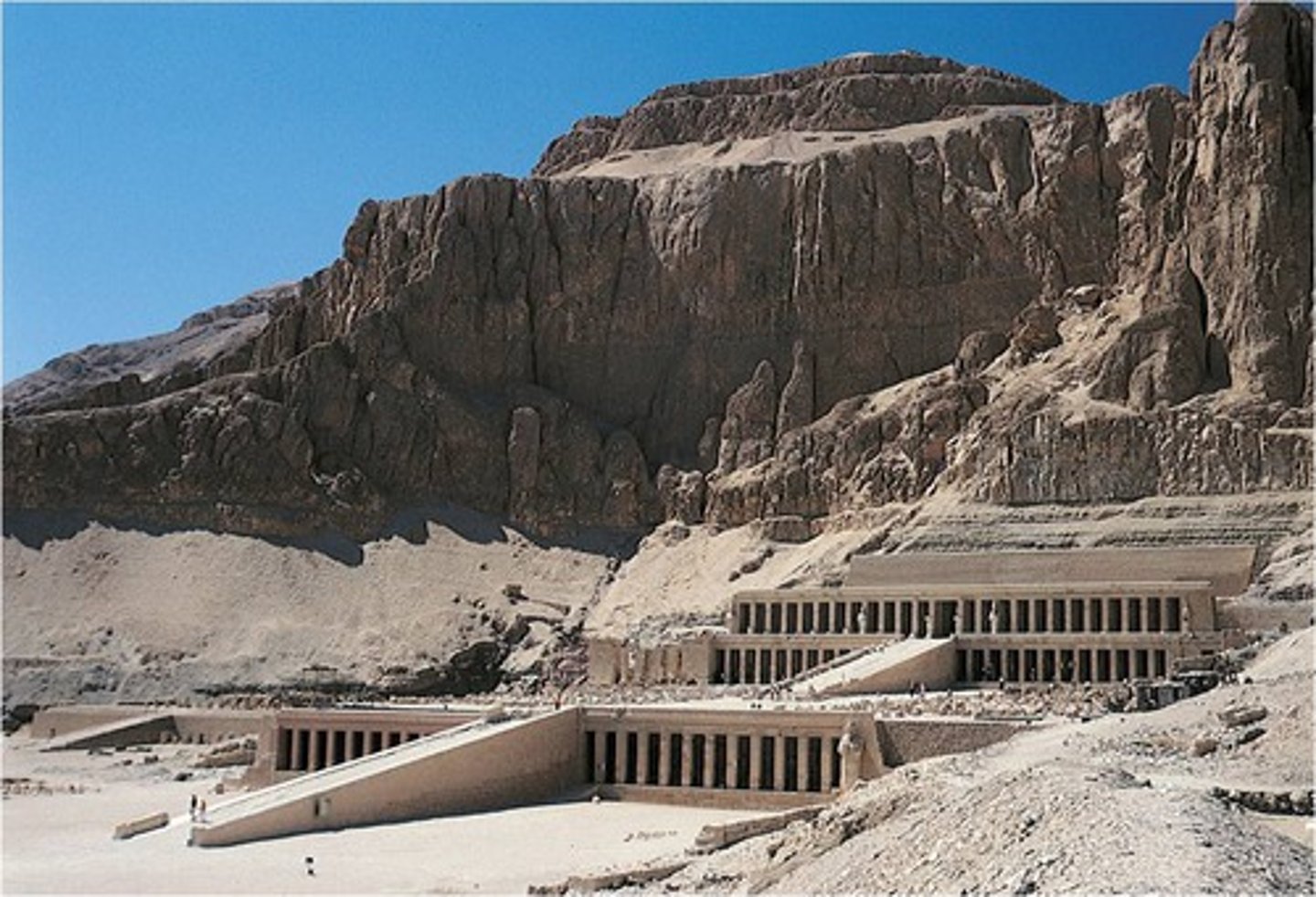
Hatshepsut's Funerary Temple ID
artist- Senmut
era-New Kingdom
audience- Hatshepsut, gods, public
patron- Hatshepsut
materials- sandstone (temple), red granite (sculpture)
techniques- colonnade, subtractive sculpture
Hatshepsut's Funerary Temple location
Luxor, West of the Nile, faces Temple of Amun-Re
Hatshepsut's Funerary Temple content
Temple: avenue of sphinx sculptures at base, stairs/ramp down the middle leading up to different levels, buts down middle with Axial plan; temples/cellas dedicated to Hathor, Amun, and Herself; size achieved by building into cliff face; colonnade to make temple look bigger; Sculpture: compact, ideal, neutral, shows power, beard of wisdom, headdress- all typical for egypt; pharaohs only kneel for gods, holding jars in hands-votive; physical signs of female are gone, inscription on base for hieroglyphic symbol for female
Hatshepsut's Funerary Temple context
Hatshepsut- first known female pharaoh rules over a prosperous and peaceful era; married to Thutmose II (half brother), he has son (Thutmose III) with another woman, he is next in line for throne; Thutmose II dies, son is too young to rule, Hatshepsut rules as a regent for 20 years, Thutmose III becomes military leader; all evidence of Hatshepsut suddenly disappears, art is defaced; Luxor= valley of Kings; Hatshepsut says she is daughter of Amun, small statue of Amun spends night in Hatshepsut's temple once a year; she has to work hard to establish power as a woman; while she lives, temple used to honor gods, after death, used to honor her- none is buried in the temple; punt- exotic location she imports plants from; power, sacred, ritual, funerary
Akhenaton, Nefertiti, and three daughters
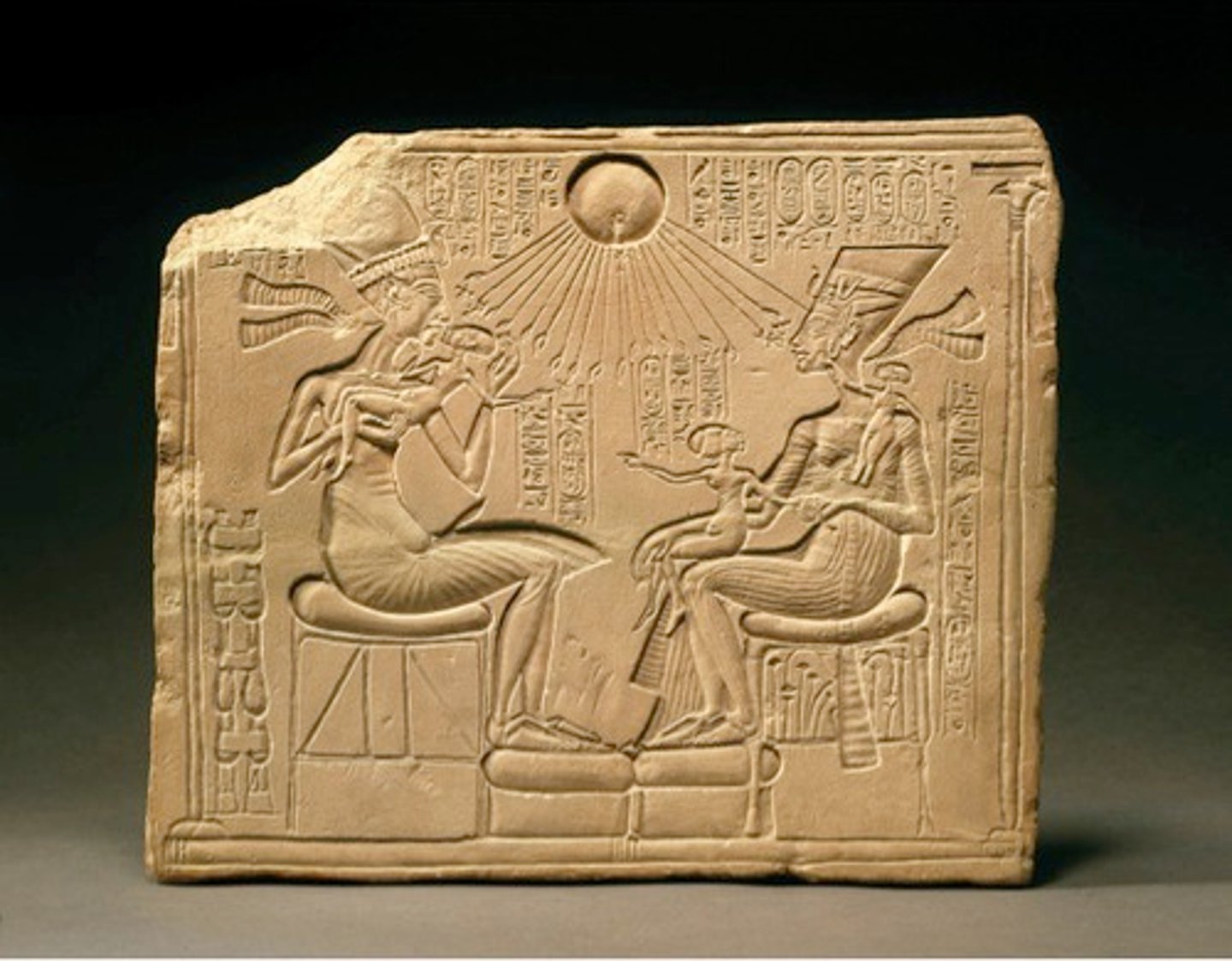
Akhenaton, Nefertiti, and three daughters ID
era- Amarna Revolution
audience- Akhenaton
patron- Akhenaton
materials- limestone, paint
technique- sunken relief
Akhenaton, Nefertiti, and three daughters location
Tell el-Amarna
Akhenaton, Nefertiti, and three daughters content
Aton (sun disk) at the top; singular cobra=only one god; hands at the end of sun rays, symbols at ends of rays are ankhs, god granting you life- Nefertiti and Akhenaton are chosen ones; hieroglyphics around god and couple giving info about them; holding 3 daughters; seated on thrones with feet off the ground- divinity; Nefertiti's throne has papyrus and lotus symbols (upper/lower Egypt); painted sunken relief, composite view, twisted perspective
Akhenaton, Nefertiti, and three daughters context
Renamed himself from Amenhotep to Akhenaton, changed name to reflect belief in one god- Aton; changes egypt from polytheism to monotheism, started to destroy art/temples for other gods; Aton is a genderless disk; Akhenaton imagery in his sculpture could reflect genderlessness of Aton, other believe it is from a disease; Akhenaton rids of Panofsky's canon and rigid/formulaic images; Akhenaton era- naturalistic, curvy, informal, intimate and expressionistic art; changes capital of Egypt to Tell el-Armana; Nefertiti= powerful woman (equal to husband); high priests mad about loss of power; this could have served as private alter art; power, religion, propaganda, domestic (family/home images)
Tutankhamun's Tomb and Innermost Coffin

Tutankhamun's Tomb and Innermost Coffin ID
era- New Kingdom
audience- gods, Tut's ka
materials- gold, enamel, precious stones
techniques- Repousse', inlay
Tutankhamun's Tomb and Innermost Coffin content
ideal, eternal young image of pharaoh; headdress of pharaoh with vulture and cobra- goddess to protect/show appeal, symbolizes upper/lower egypt; beard of wisdom; holding crook (hook) and flail (whip)-power symbols; inlaid vulture that wraps wings around torso; inlaid semi precious stones
Tutankhamun's Tomb and Innermost Coffin context
Tut (son of Akhenaton) restores polytheism, Panofsky's canon, and Thebes as capital; Tut takes throne at 9, rules for 10 years until sudden death; tomb discovered in 1922 by Howard Carter; tomb separated into 3 rooms- burial chamber and treasury rooms. burial chamber house 3 sarcophagi (stone, wood, gold); Tut's tomb completely intact; internal organs kept, but taken out of body so it won't decompose/rot; egyptians believes gods had golda skin, silver bones, and lapis lazuli hair- reflects Tut's coffin to be made of those materials, he is god in death; reunites with sun god, reflective skin material of gold; repousse'- to push out the detail; funerary, power, ritual, religion
Last Judgement of Hu-Nefer

Last Judgement of Hu-Nefer ID
era- New Kingdom
audience- Hu-Nefer's ka, gods
patron- Hu-Nefer?
materials- paint, papyrus
techniques- continuous narration, painting
Last Judgement of Hu-Nefer location
Hu-Nefer's tomb
Last Judgement of Hu-Nefer content
Top: Hu-Nefer explainign his good deeds to the gods; bottom reads lets to right, Hu-Nefer with Anubis (god of dead/mummification)- head of jackal; Anubis balancing out scale so Hu-Nefer's heart is weighed against feather; Ma-at at top of scale- goddess of morality, good deeds, and ethics; Ammit- eater of the dead, eats person if heart is heavier than feather; Toth records results; Hu-Nefer escorted to Osiris by Horus; Osiris's daughters guard internal organs; Panofsky's canon used
Last Judgement of Hu-Nefer context
Hu-Nefer was preist/scribe; Book of the Dead- instruction manual for afterlife, been around for all of Egyptian history; continuous narrative; funerary, narrative, ritual